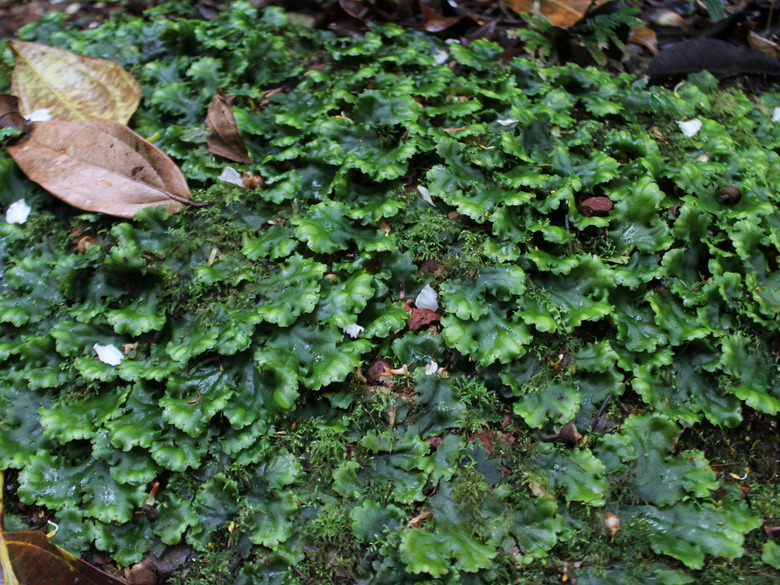How To Kill Liverwort Weed
We may receive a commission on purchases made from links.
Liverwort (Marchantia polymorpha) is a widespread weed occurring in all U.S. Department of Agriculture plant hardiness zones, from tropical to arctic regions. It commonly grows in container nursery stock and can infest greenhouses and excessively moist areas in lawns. Liverwort grows flat on the ground, forming dense mats that block water from reaching the roots of nearby plants. This primitive, moss-like weed is difficult to eradicate, but preventive methods and natural and chemical herbicides can help to eliminate or kill liverwort weed.
Liverwort Spread and Invasion
Liverwort Spread and Invasion
Liverwort weeds reproduce in two ways. They produce tiny spores that are carried by air currents to new areas where the spores become new weeds. Liverwort also reproduces by forming small, bud-like branches, called gemmae, in cup-like surface structures. The gemmae detach from the plant by mechanical forces, such as falling raindrops or overhead irrigation, and then they form new plants in nearby areas.
Hand-pulling the weed is not recommended, because plant parts containing gemmae may break off and spread the weed. Cultural methods that take advantage of how liverwort grows and spreads help to control the weed.
Before You Begin
Before You Begin
Put on safety goggles, gloves and other safety gear before using compost or mulch and applying any herbicide product, whether "natural" or chemical. Even household vinegar can damage your eyes and skin, and horticultural levels of 20 to 30 percent should be treated with extreme caution. Check the label carefully and apply only to the liverwort or other weeds according to the package directions. All herbicides can affect your desirable plants as well as the weeds, so avoid accidentally spraying other plants in the garden or greenhouse.
In addition, use caution when applying algaecide or herbicide products near wetlands, bodies of water and waterways. While they may kill the liverwort, they can also affect the natural and beneficial algae and other plants in the vicinity.
Growth Condition Control
Growth Condition Control
The conditions that help plants grow, such as moisture and fertilization, also promote growth of liverwort. Avoiding overwatering plants, and letting the surface of the growing medium to dry out helps to reduce the growth of liverwort and may kill it, because liverwort does not have normal or deep roots.
Use of coarse mulch, such as cocoa hull mulch, reduces surface moisture and also controls liverwort infestation. Another method is to increase airflow in the environment to reduce humidity and so slow liverwort growth. Airflow can also be increased by spacing plants father apart and adding fans to indoor spaces and greenhouses. Incorporating fertilizer into the planting medium, instead of applying it to the surface, is another way to prevent the spread of liverwort.
Natural Herbicide Control
Natural Herbicide Control
Herbicides produced from natural sources, called "biorational herbicides," can reduce or eliminate liverwort weeds. These herbicides are thought not to harm beneficial organisms and don't have significant adverse environmental effects.
Herbicides containing vinegar or acetic acid, pelargonic acid or oregano extract may help control liverwort invasions. Apply acetic acid as a 10 to 20 percent solution, pelargonic acid as a 3 percent and oregano oil extract as a 2 percent solution with a sprayer. Other natural herbicides, such as cinnamon and rosemary oil combinations or clove, rosemary and thyme oil combinations, are not effective against liverwort.
Chemical Herbicide Control
Chemical Herbicide Control
Several chemical herbicides, such as flumioxazin, quinoclamine and sodium carbonate peroxyhydrate, are effective against liverwort, especially if the infestation is not very large. Flumioxazin is available in granular form; it is only recommended for field or nursery container plants and not for indoor use. Quinoclamine is an algaecide and is also not registered for indoor greenhouse use.
Sodium carbonate peroxyhydrate comes in granular form and breaks down into sodium carbonate and hydrogen peroxide when it comes in contact with water. It is labeled for greenhouse use and can be applied at about 0.1 pound per square foot. It combats liverwort infestations by killing its spores and may be effective even after liverwort has taken over.
